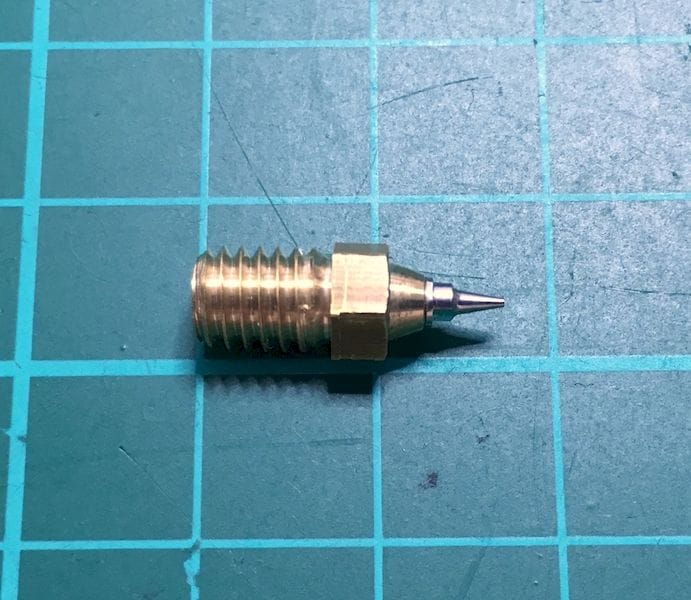![An airbrush nozzle adapted for use on a 3D printer [Source: Well Engineered]](https://fabbaloo.com/wp-content/uploads/2020/05/image-asset_img_5eb0a58cc5baa.jpg)
There may be a far better way to 3D print small, finely detailed objects.
I’m reading a post by René Jurack, who proposes a new style of 3D printer nozzle specifically for use in 3D printing highly detailed small objects.
The issue is resolution. Most extrusion-based 3D printers employ a standard 0.4mm nozzle, whose extrusion line is a great compromise between material volume (for speed) and thinness (for resolution and accuracy).
There are kits and third party options to make adjustments to this by swapping out the 0.4mm nozzle and replacing it with a larger or smaller nozzle. Typically this is done for larger prints, where a slightly larger nozzle size can deliver a significantly larger amount of material volume. This can dramatically lower print durations.
Similarly some people install smaller nozzles in an attempt to achieve higher print resolutions. The most typical size for smaller fine detail nozzles is 0.25mm, which provides 60% less material per time unit. Of course, speeds and feeds on the slicing program must be adjusted accordingly, but this does work.
Almost.
The problem is that by definition the nozzle is hot in order to soften the filament for extrusion. The nozzle is bolted to the heater block, a large chunk of metal that’s actively heated, and the heat transfers down to the nozzle.
This configuration creates a rather hot zone through radiant heat. If you’re 3D printing very fine details – and that’s what this is all to achieve – then you risk your fine structures distorting by being exposed to this radiant heat.
Thus some have experienced poor results when using 0.25mm nozzles, depending on the geometry of the 3D model in question.
Now there could be a solution for this issue from René Jurack, who was inspired by airbrush nozzles. These have a rather long neck, creating distance from the end to tip. The idea here is to use that distance to reduce the effect of radiant heat on the fragile print.
![18mm figurine 3D printed with an adapted airbrush nozzle [Source: Well Engineered]](https://fabbaloo.com/wp-content/uploads/2020/05/airbrush-sample_result_img_5eb0a58d0b280.jpg)
Jurack explains:
“A big problem with small. hot and slow prints is the heatradiation of the hotend and nozzle itself. To get as little as possible heat into the print, the nozzle needs to be as long and pointy as possible. The longer the nozzle, the bigger the distance between heaterblock and the print. And the more pointy it is, the less heat radiation can affect the print. A nice side benefit: the cooling fan can blow better onto the print and “around” the nozzle.”
Jurack found that the stock airbrush nozzle did not fit in his standard E3D-Online hot end, so he designed an adapter.
![Airbrush nozzle adapter design for 3D printers [Source: Well Engineered]](https://fabbaloo.com/wp-content/uploads/2020/05/image-asset_img_5eb0a58d4b458.jpg)
The adapter can be made with the blueprint provided to the public by Jurack, or also purchased on his site for only €19 (US$22).
![Detail of a #3DBenchy print using an airbrush nozzle [Source: Well Engineered]](https://fabbaloo.com/wp-content/uploads/2020/05/image-asset_img_5eb0a58d79a9a.jpg)
This is a very sensible idea, although it would require a significant readjustment of your extruder position and may even cause the loss of some vertical height in the build volume. However, small prints are usually not particularly tall.
It seems to me that forward-looking third party suppliers like E3D-Online might want to add something like this to their arsenal of hot end equipment.
Via Well Engineered











An Austrian company has developed an incredibly sophisticated end-to-end automation system for metal 3D print post processing.